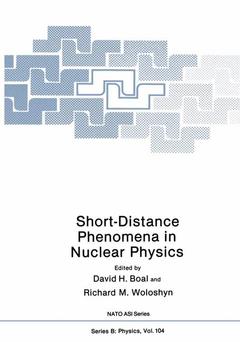Short-Distance Phenomena in Nuclear Physics, Softcover reprint of the original 1st ed. 1983 NATO Science Series B: Series, Vol. 104
Langue : Anglais
Coordonnateurs : Boal David H., Woloshyn Richard M.

Each summer, the Theoretical Physics Division of the Canadian Association of Physicists organizes a summer institute of two weeks duration on a current topic in theoretical physics. This volume contains the lectures from the Pacific Summer Institute held at Pearson College on Vancouver Island, B. C. (Canada) from August 23 to September 3, 1982. The Institute was titled "Progress in Nuclear Dynamics: Short-Distance Behavior in the Nucleus". The primary source of funds for the Institute came from NATO through its Advanced Study Institute programme. Significant finan cial support is also gratefully acknowledged from TRIUMF, Simon Fraser University, Natural Sciences and Engineering Research Council of Canada, and Atomic Energy of Canada Ltd. The topic of the school was the role of the substructure of hadrons--quarks and gluons--in nuclear physics. This includes not only the effects which may be observed in specific nuclear states, such as form factors at large momentum transfer, or the presence of hidden color components in the ground states of few nucleon systems, but also effects which may be observed in the nuclear matter contin uum: the phase transition from normal nuclear matter to a plasma of quarks and gluons. The current status of the long distance phenom enology of the nucleus--the interacting boson approximation and the role of n's and ~'s in nuclear structure, is also reviewed.
QCD as a Basis for Quark and Nuclear Forces.- Why Believe in QCD?.- The Successes and Failures of the Constituent Quark Model.- Valon Model for Hadrons and their Interactions.- Multi-Quark States and Potential Models.- Nuclear Chromodynamics: Implications of QCD for Nuclear Physics.- The Thermodynamics of Strongly Interacting Matter.- Anomalons, Honey and Glue in Nuclear Collisions.- Pions from and about Heavy Ions.- Nuclear and Particle Physics in the Early universe.- The Interacting Boson Model.- Role of Pions and Isobars in Nuclei.- Nuclear Structure, Double Beta Decay and Giant Resonances.- Unity in Diversity—A Summary Talk.
Date de parution : 02-2012
Ouvrage de 438 p.
17.8x25.4 cm
Mots-clés :
hadron; heavy ion; nuclear physics; nucleon; particle physics
© 2024 LAVOISIER S.A.S.



